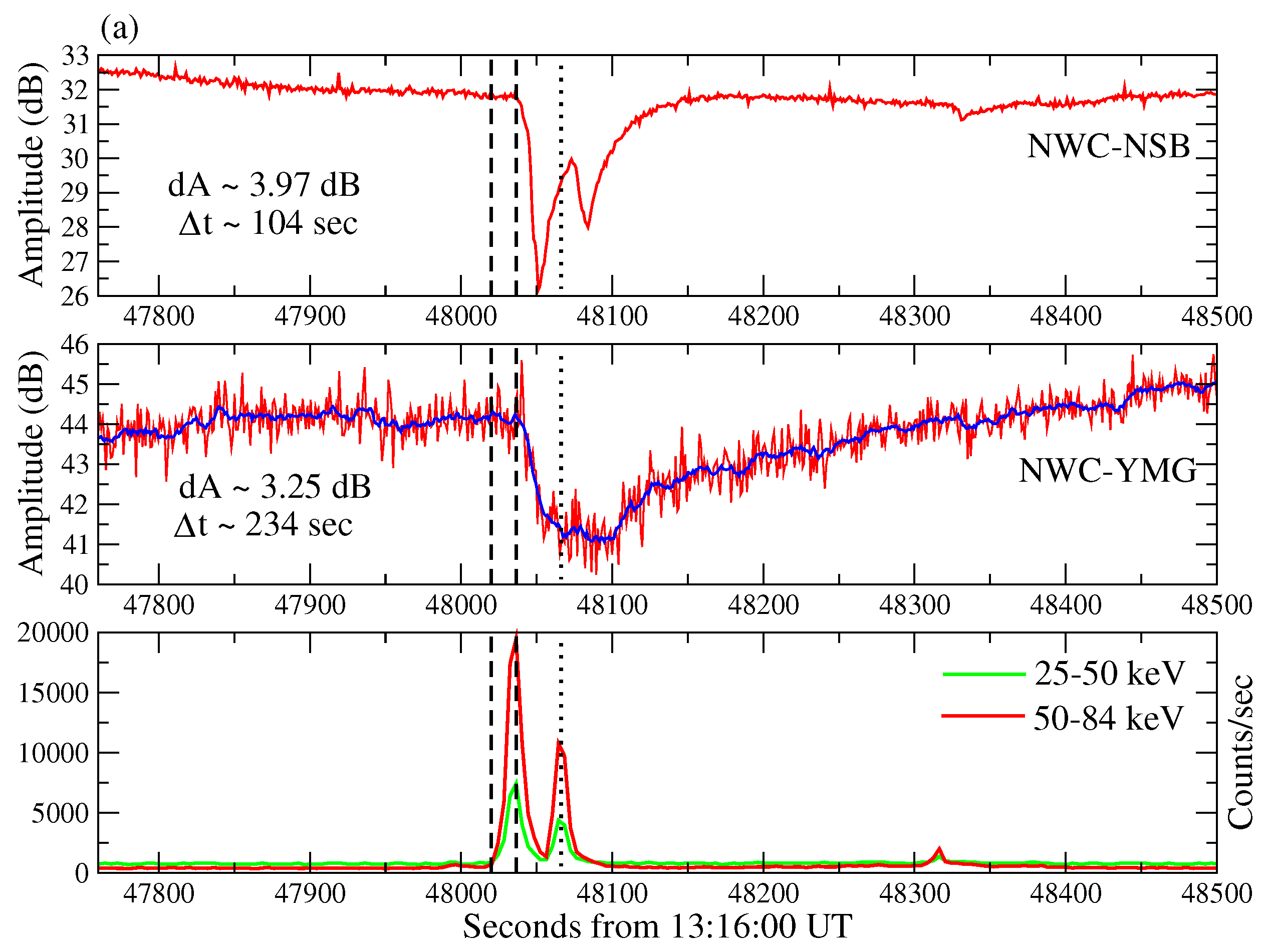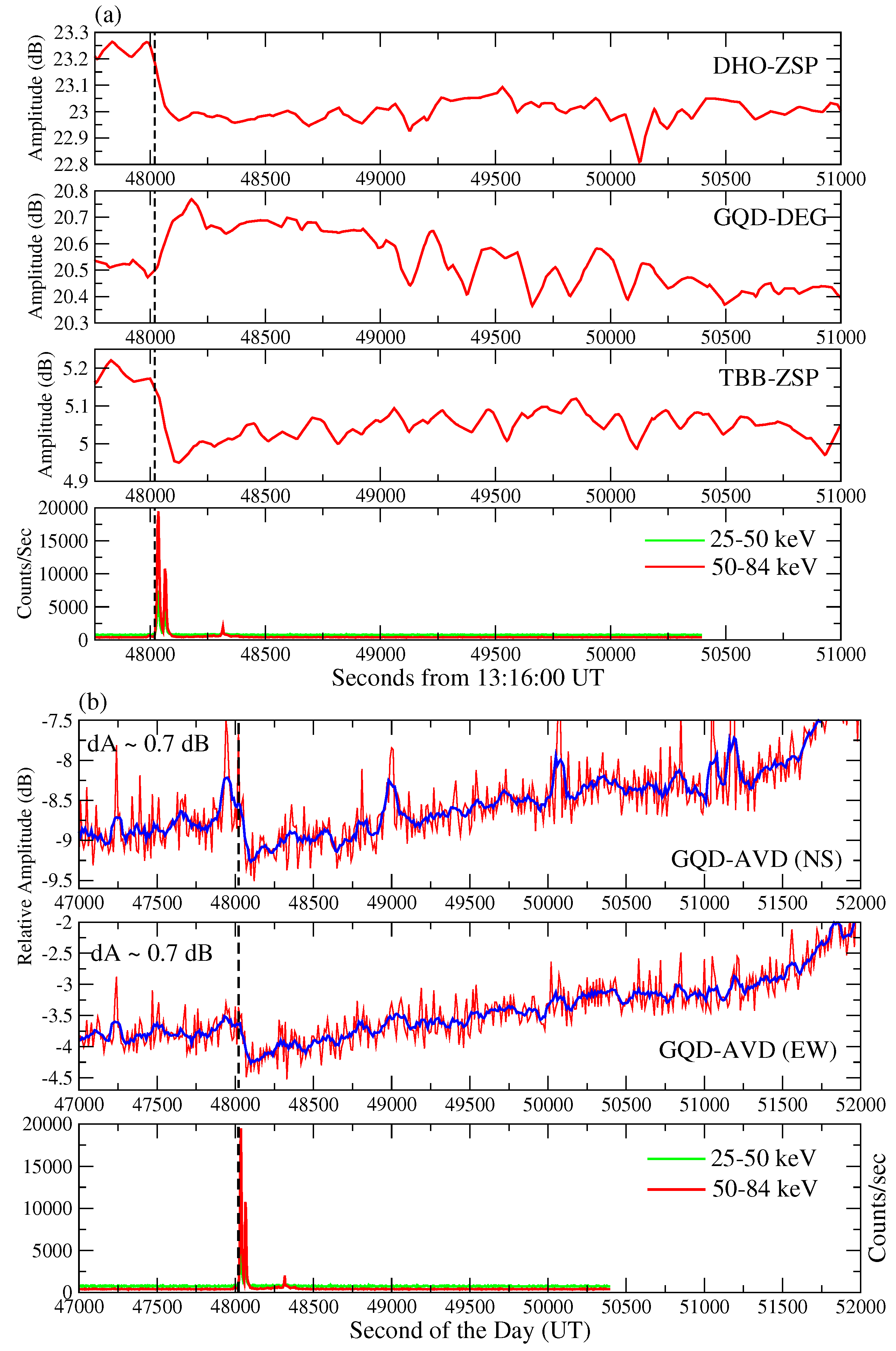First Detection of Global Ionospheric Disturbances Associated with the Most Powerful Gamma Ray Burst GRB221009A
Abstract
:1. Introduction
2. Data and Methodology
3. Results and Discussion
3.1. Night Side Ionosphere
3.2. Day Side Ionosphere
Effects on LF Signals
4. Conclusions
Author Contributions
Funding
Institutional Review Board Statement
Informed Consent Statement
Data Availability Statement
Acknowledgments
Conflicts of Interest
References
- Mitra, A.P. Ionospheric Effects of Solar Flares; Astrophysics ans Space Science Library, 46, D. Reidel Publishing Company: Boston, MA, USA, 1974; Volume 46. [Google Scholar]
- Thomson, N.R.; Clilverd, M.A. Solar flare induced ionospheric D-region enhancements from VLF amplitude observations. J. Atmos. Terr. Phys. 2001, 63, 1729–1737. [Google Scholar] [CrossRef]
- Zigman, V.; Grubor, D.; Sulic, D. D-region electron density evaluated from VLF amplitude time delay during X-ray solar flare. J. Atmos. Sol. Terr. Phys. 2007, 69, 775. [Google Scholar] [CrossRef]
- Palit, S.; Basak, T.; Mondal, S.K.; Pal, S.; Chakrabarti, S.K. Modeling of the very-low-frequency (VLF) radio wave signal profile due to solar flares using the GEANT4 Monte Carlo simulation coupled with Ionospheric chemistry. Atmos. Chem. Phys. Discuss. 2013, 13, 6007–6033. [Google Scholar] [CrossRef] [Green Version]
- Araki, T. Anomalous phase changes of transequatorial VLF radio waves during geomagnetic waves. J. Geophys. Res. 1974, 79, 4811–4816. [Google Scholar] [CrossRef]
- Marubashi, K.; Reber, C.A.; Taylor, H.A., Jr. Geomagnetic storm effects on the thermosphere and the ionosphere revealed by in situ measurements from OGO 6. Planet. Space Sci. 1976, 24, 1031–1041. [Google Scholar] [CrossRef]
- Kikuchi, T.; Evans, D.S. Quantitative study of substorm-associated VLF phase anomalies and precipitating energetic electrons on November 13, 1979. J. Geophys. Res. 1983, 88, 871. [Google Scholar] [CrossRef]
- Rozhnoi, A.; Solovieva, M.S.; Molchanov, O.A.; Hayakawa, M. Mid-latitude LF (40 kHz) phase variations associated with quiet and disturbed geomagnetic conditions. Phys. Chem. Earth. 2004, 29, 589–598. [Google Scholar] [CrossRef]
- Peter, W.B.; Chevalier, M.W.; Inan, U.S. Perturbations of midlatitude sub-ionospheric VLF signals associated with lower ionospheric disturbances during major geomagnetic storms. J. Geophys. Res. 2006, 111, A03301. [Google Scholar] [CrossRef]
- Tatsuta, K.; Hobara, Y.; Pal, S.; Balikhin, M. Sub-ionospheric VLF signal anomaly due to geomagnetic storms: A statistical study. Ann. Geophys. 2015, 33, 1457–1467. [Google Scholar] [CrossRef] [Green Version]
- Mondal, S.K.; Pal, S.; Sen, A.; Rahaman, M.; Midya, S.K. Long-lasting disturbances in the mid-latitude sub-ionospheric VLF radio signal during the super geomagnetic storm of 17th March 2015. Adv. Space Res. 2021, 68, 2295–2308. [Google Scholar] [CrossRef]
- Fishman, G.; Inan, U.S. Observation of an ionospheric disturbance caused by a gamma-ray burst. Nature 1988, 331, 418–420. [Google Scholar] [CrossRef]
- Inan, U.S.; Lehtinen, N.G.; Lev-Tov, S.J.; Johnson, M.P.; Bell, T.F.; Hurley, K. Ionization of the lower ionosphere by gamma rays from a Magnetar: Detection of a low energy (3–10 keV) component. Geophys. Res. Lett. 1999, 26, 3357–3360. [Google Scholar] [CrossRef]
- Inan, U.S.; Lehtinen, N.G.; Moore, R.C.; Hurley, K.; Boggs, S.; Smith, D.M.; Fishman, G. Massive disturbance of the daytime lower ionosphere by the giant γ-ray flare from magnetar SGR 1806-20. J. Geophys. Res. Lett. 2007, 34, 8103. [Google Scholar] [CrossRef] [Green Version]
- Tanaka, Y.T.; Terasawa, T.; Yoshida, M.; Horie, T.; Hayakawa, M. Ionospheric disturbances caused by SGR 1900+14 giant gamma ray flare in 1998: Constraints on the energy spectrum of the flare. J. Geophys. Res. 2008, 113, A07307. [Google Scholar] [CrossRef]
- Tanaka, Y.T.; Raulin, J.P.; Bertoni, C.P. First VLF detection of short repeated bursts from magnetar SGR J1550–5418. Astrophys. J. Lett. 2010, 721, 1. [Google Scholar] [CrossRef]
- Baktash, A.; Horns, D.; Meyer, M. Interpretation of multi-TeV photons from GRB221009A. arXiv 2022, arXiv:2210.07172v1. [Google Scholar]
- Appleton, E.V.J. A note on the “sluggishness” of the ionosphere. J. Atmos. Terr. Phys. 1953, 3, 282–284. [Google Scholar] [CrossRef]
- Palit, S.; Basak, T.; Pal, S.; Chakrabarti, S.K. Theoretical study of lower ionospheric response to solar flares: Sluggishness of D-region and peak time delay. Astrophys. Space Sci. 2014, 355, 2190. [Google Scholar] [CrossRef]
- Palit, S.; Raulin, J.P.; Correia, E. Lower ionospheric plasma-chemical evolution and VLF signal modulation by a series of SGR X-ray bursts: Numerical simulation with an ion-chemistry model. J. Geophys. Res. Space Physics 2018, 123, 7930–7942. [Google Scholar] [CrossRef]





| Tx. Frequency (kHz) | Tx. Location | GCP (km) | (dB) | (Min) |
|---|---|---|---|---|
| Nighttime ionosphere | ||||
| 19.8 (NWC-NSB) | 21.81 S, 114.16 E | 7920 | −3.97 | 1.7 |
| 19.8 (NWC-YMG) | 21.81 S, 114.16 E | 6490 | −3.25 | 3.8 |
| 22.2 (JJI-NSB) | 32.09 N, 130.82 E | 1775 | −2.75 | 2.5 |
| 40.0 (JJY-YMG) | 37.37 N, 140.84 E | 916 | −3.10 | 3.5 |
| Daytime ionosphere | ||||
| 19.8 (DHO-ZSP) | 53.08 N, 7.60 E | 551 | −0.30 | 40 |
| 19.58 (GQD-DEG) | 54.91 N, 3.27 W | 1100 | +0.28 | 23 |
| 26.7 (TBB-ZSP) | 37.40 N, 27.32 E | 1930 | −0.22 | 30 |
| 22.1 (GQD-AVD) | 54.91 N, 3.27 W | 14320 | −0.7 | 15 |
| 62.6 (FUG-KLM) | 43.38 N, 2.09 E | 1100 | +4.95 | 61 |
| 63.9 (FUE-KLM) | 48.63 N, 4.35 W | 1340 | −2.85 | 48 |
Disclaimer/Publisher’s Note: The statements, opinions and data contained in all publications are solely those of the individual author(s) and contributor(s) and not of MDPI and/or the editor(s). MDPI and/or the editor(s) disclaim responsibility for any injury to people or property resulting from any ideas, methods, instructions or products referred to in the content. |
© 2023 by the authors. Licensee MDPI, Basel, Switzerland. This article is an open access article distributed under the terms and conditions of the Creative Commons Attribution (CC BY) license (https://creativecommons.org/licenses/by/4.0/).
Share and Cite
Pal, S.; Hobara, Y.; Shvets, A.; Schnoor, P.W.; Hayakawa, M.; Koloskov, O. First Detection of Global Ionospheric Disturbances Associated with the Most Powerful Gamma Ray Burst GRB221009A. Atmosphere 2023, 14, 217. https://doi.org/10.3390/atmos14020217
Pal S, Hobara Y, Shvets A, Schnoor PW, Hayakawa M, Koloskov O. First Detection of Global Ionospheric Disturbances Associated with the Most Powerful Gamma Ray Burst GRB221009A. Atmosphere. 2023; 14(2):217. https://doi.org/10.3390/atmos14020217
Chicago/Turabian StylePal, Sujay, Yasuhide Hobara, Alexander Shvets, Peter Wilhelm Schnoor, Masashi Hayakawa, and Oleksandr Koloskov. 2023. "First Detection of Global Ionospheric Disturbances Associated with the Most Powerful Gamma Ray Burst GRB221009A" Atmosphere 14, no. 2: 217. https://doi.org/10.3390/atmos14020217
APA StylePal, S., Hobara, Y., Shvets, A., Schnoor, P. W., Hayakawa, M., & Koloskov, O. (2023). First Detection of Global Ionospheric Disturbances Associated with the Most Powerful Gamma Ray Burst GRB221009A. Atmosphere, 14(2), 217. https://doi.org/10.3390/atmos14020217








